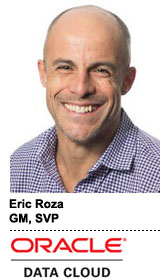 Since Oracle Data Cloud’s creation four years ago, following the acquisitions of data sellers Datalogix and BlueKai, it has taken a central role in powering Oracle’s core products.
Since Oracle Data Cloud’s creation four years ago, following the acquisitions of data sellers Datalogix and BlueKai, it has taken a central role in powering Oracle’s core products.
Oracle Data Cloud further enhanced its ability to measure the digital media supply chain with its $850 million acquisition of Moat and the $400 million acquisition of Grapeshot.
AdExchanger spoke with Eric Roza, Oracle’s senior VP and general manager of the data cloud, about how the new tools will be brought to market in an ecosystem full of competitor-partners, after an extended quiet period for the Oracle Data Cloud since it bought Grapeshot.
AdExchanger: Oracle Data Cloud has made some high-profile deals recently, so what’s the opportunity you see and the strategy you’re pursuing?
ERIC ROZA: Data and analytics will be increasingly valuable. Independent of shifts in regulatory conditions, which media companies are succeeding, walled-garden dynamics or pick any other trend, when the dust settles there will be a global measured advertising industry in the trillion-dollar range.
We’re not going to get into a mode where we’re activating media as a buyer or media company. We’re going to stay out of that business. But there’s a big opportunity to add value to the buy and sell sides and the programmatic Lumascape and not be on either side.
What’s the opportunity?
We’re in a unique position in terms of our scale and being able to work with everyone, walled gardens included, to create value and do things even they can’t do themselves.
The trend is to more scaled, essential or near-essential platforms that own ad tech and media. I see the attraction in getting in to that business, but for us the opportunity is in being able to play on both sides of the exchange and across all these walled gardens.
Just tracking press releases, you seem to be on a partnership spree with companies like MediaMath, dataxu and Tremor Video DSP since adding Moat and Grapeshot.
When we recently did a review of where our customers use our audience, context or measurement data, on average it’s across 10 or more platforms. And that’s accelerating when you get to the level of global scale.
Take a company like Google or Verizon. We could have a dozen or more integrations with each of those companies.
What do those integrations look like?
Say we’re working on a brand safety program with a big video platform and with another part of the org we’re working on audience segments in a certain country; How do we know what’s important to them and to us and to cycle our engineering resources?
We spend a tremendous amount of time thinking about how to optimize relationships and integrations.
How big is the commitment to those kind of third-party partner integrations?
The cost of ubiquity is high. We have hundreds of people in our organization focused purely on these integrations and partnerships. And for instance we have people on the ground in China and very big investments now that we know could take a couple years to pay off.
And that’s a good example of the opportunity to be the global scaled, independent player in measurement and data. It’s a market where we know we’ll need to be and we can work with the Tencents, Alibabas and Baidus and be the connective technology layer. Walled gardens and companies with competitive distractions in their business couldn’t make those inroads, and it takes this huge investment to make it work.
And in a post-GDPR world it means a lot that we bring our scale and how much we have at stake in getting it right. If you’re a company with a half-billion dollar market cap – hey, that’s a great startup – but at this level it’s like you don’t have much to lose.
How has the competitive landscape changed for you with other marketing clouds or media and analytics businesses?
We’re trying to create value – for Oracle shareholders, customers and partners – and we’ve found the best way to create value is to not get overly hung up on competitive issues.
If an aspect of a partnership can add value to the constituents, we aren’t going to hold up dotting i’s and crossing the t’s based on potential other channel conflicts. We certainly consider conflicts, but I think most others start from “no” and we start from “yes” and if a problem shows up in testing then we get to “no.”
People who don’t view the world in this post-competitive sense, especially in digital marketing, are on a fast road to obsolescence.
What’s on the product road map or the kinds of data or tech you’re looking to add to the data cloud?
The problem and the opportunity with being at Oracle is that everyone wants to approach you about selling their business. But we tend to be very thematic.
After Adobe bought TubeMogul I think 10 investment bankers came knocking about selling a video DSP. That’s the worst way to approach us. TubeMogul and Adobe are important partners and we feel we understand what game Adobe is playing, but that in no way informs our decisions.
What we’re interested in is people who have given a lot of thought to the game we’re playing, our thesis around audience, identity, context and measurement, and understands how their product relates to that and extends our capabilities in a scalable way.
This post was syndicated from Ad Exchanger.


More Stories
The Pros And Pitfalls Of AI; Dating App Data Is A No-Go
Latest promo agency shaking up the scene
The State of Sustainability: The Hot, Hard Truth